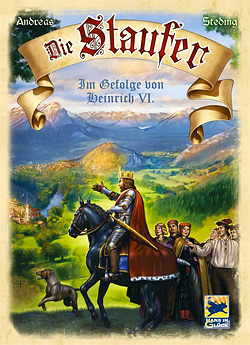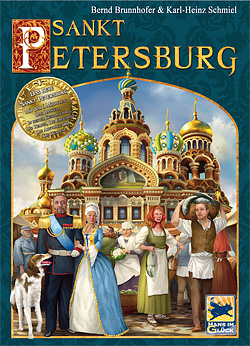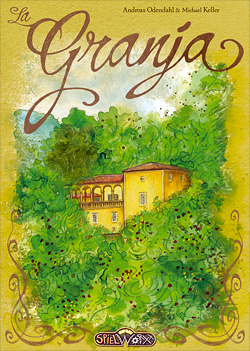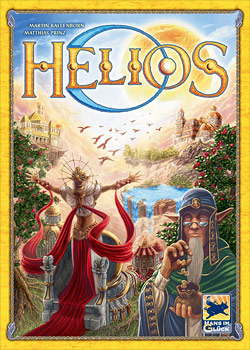 In this highly anticipated game published by Hans im Glück we travel through Asia following the footsteps of Marco Polo and on our arrival build trading posts. From now on, we are able to trade gold, pepper and silk there. If these locations coincide with our personal goal cards we receive additional victory points at end of the game.
In this highly anticipated game published by Hans im Glück we travel through Asia following the footsteps of Marco Polo and on our arrival build trading posts. From now on, we are able to trade gold, pepper and silk there. If these locations coincide with our personal goal cards we receive additional victory points at end of the game.
The supply of goods is handled by a very nice dice-worker-placement mechanism and these goods can into victory points using contracts or our trading posts.
But the icing on the cake and a real highlight are the characters. Each player at the beginning of the game takes in a different role card with specific game advantages. Adjusting one’s tactics to those characters is the key to victory! Even if this has not worked so properly in the first few games, this and the variable game setup provide many challenges for ongoing fun in many more plays.
 “The Staufer Dynasty” is, after “Hansa Teutonica”, the second game by Andreas Steding, which is awarded our Game of the Month title. This time, he has come up with a roundel as a new mechanism, where our workers move and try to win majorities. Workers and movement points are scarce and thus it is important to keep a close eye on the other players. Hence interaction is guaranteed. The amazingly simple but remarkable mechanism for determining the order of play as well as the secret end game goals add the extra something to the game. Although some might have preferred a little less of that something.
“The Staufer Dynasty” is, after “Hansa Teutonica”, the second game by Andreas Steding, which is awarded our Game of the Month title. This time, he has come up with a roundel as a new mechanism, where our workers move and try to win majorities. Workers and movement points are scarce and thus it is important to keep a close eye on the other players. Hence interaction is guaranteed. The amazingly simple but remarkable mechanism for determining the order of play as well as the secret end game goals add the extra something to the game. Although some might have preferred a little less of that something. This game has been one of our most-discussed and played games in the past, and of course there is the computer conversion by our Westpark member Günther Rosenbaum. So everybody was happy to get this game back on the table, in its shiny new version with added expansions and new tactical possibilities.
This game has been one of our most-discussed and played games in the past, and of course there is the computer conversion by our Westpark member Günther Rosenbaum. So everybody was happy to get this game back on the table, in its shiny new version with added expansions and new tactical possibilities. If someone had told George Orwell in the year 1948 that humanity would deliberately try to create the perfect dystopia in the future, he would have thought they are mad.
If someone had told George Orwell in the year 1948 that humanity would deliberately try to create the perfect dystopia in the future, he would have thought they are mad. “La Granja” offers interaction and competition, constructive and progressive development, optimization in selection and sequence as well as an abundance of possibilities to bypass bottlenecks in supply and demand. Everything has effects and side effects. Despite its countless dependencies, the complexity is easily manageable. The game’s elements and mechanics are superbly supported by the graphics design and the superbly structured rules.
“La Granja” offers interaction and competition, constructive and progressive development, optimization in selection and sequence as well as an abundance of possibilities to bypass bottlenecks in supply and demand. Everything has effects and side effects. Despite its countless dependencies, the complexity is easily manageable. The game’s elements and mechanics are superbly supported by the graphics design and the superbly structured rules. With his vast experience as a game designer, Rüdiger Dorn has created a solid game, which provides smooth, well-rounded gameplay without creating aggression or frustration. It offers easily detectable solutions or alternative solutions for each situation, and conveys pure, constructive fun. The game material supports this excellently and even a five-player game is pleasing and playful. A worthy winner of the “Kennerspiel” award.
With his vast experience as a game designer, Rüdiger Dorn has created a solid game, which provides smooth, well-rounded gameplay without creating aggression or frustration. It offers easily detectable solutions or alternative solutions for each situation, and conveys pure, constructive fun. The game material supports this excellently and even a five-player game is pleasing and playful. A worthy winner of the “Kennerspiel” award. “Helios” many tactical options create a high replay value and provide a well-rounded, fast yet relaxed, constructive gameplay. And its concise rules, its great freedom of action and the many different winning strategies make “Helios” without any doubt a “gamer’s game” and a worthy recipient of our “Game of the Month” title.
“Helios” many tactical options create a high replay value and provide a well-rounded, fast yet relaxed, constructive gameplay. And its concise rules, its great freedom of action and the many different winning strategies make “Helios” without any doubt a “gamer’s game” and a worthy recipient of our “Game of the Month” title. This little card game by the Kramer/Kiesling team offers a thrilling battle for the highest and thickest card multi-tuple. On each turn, even those of your fellow gamers, everyone is involved. This interactivity is highly complex and the goddess of fortune is also given a nice spot. But according to the law of large numbers, the influence of luck is balanced out sooner or later.
This little card game by the Kramer/Kiesling team offers a thrilling battle for the highest and thickest card multi-tuple. On each turn, even those of your fellow gamers, everyone is involved. This interactivity is highly complex and the goddess of fortune is also given a nice spot. But according to the law of large numbers, the influence of luck is balanced out sooner or later.